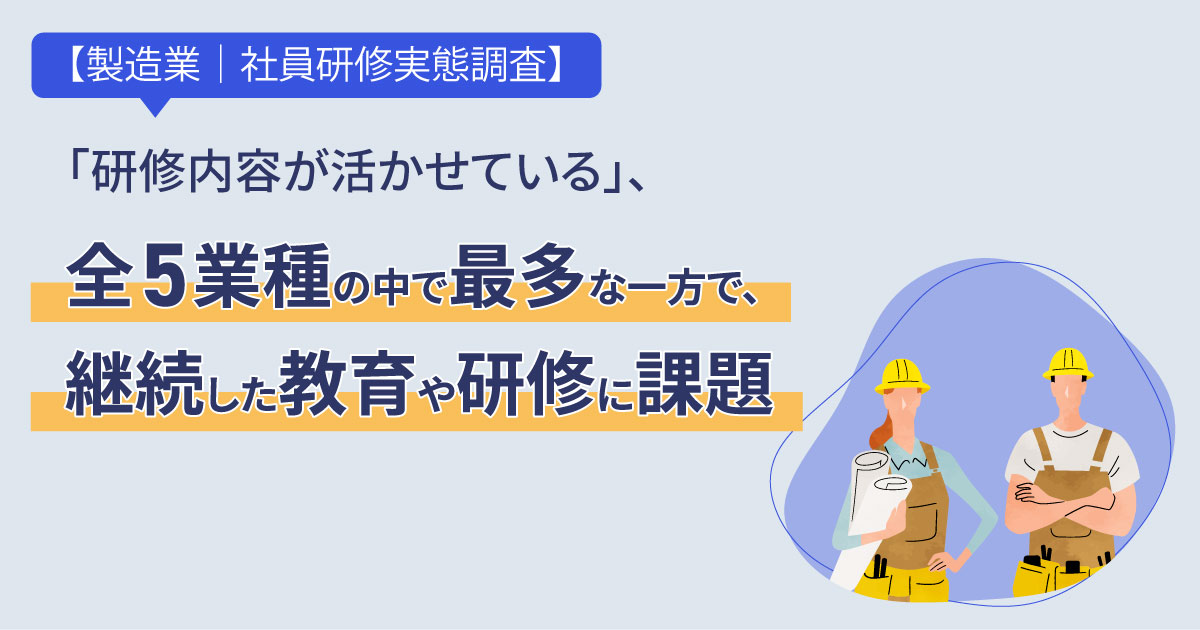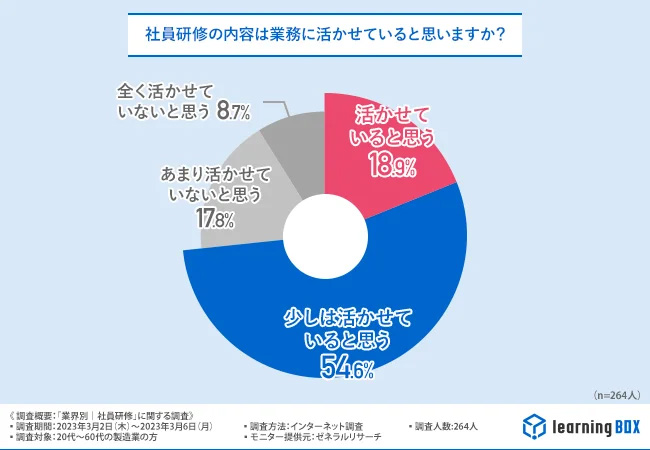
LearningBOX, Inc. conducted a survey on "Employee Training by Industry" among manufacturers in their 20s to 60s.
Of the results of the survey, which covered a total of five industries*, we are pleased to announce the results for the manufacturing industry.
*5 industries in total: medical care, finance, retail, manufacturing, and local government.
Survey Results Topics
z More than 70% of respondents answered that the content of employee training is being applied to their work, with the manufacturing industry accounting for the largest number of respondents among the five industries.
zOn the other hand, more than 70% of respondents answered that the training content "needs to be changed every year.
<Survey Summary
1. survey method: web-based questionnaire using monitors from General Research Corporation
2. survey target: registered monitors of General Research who are in their 20s to 60s and work in the manufacturing industry.
3. number of valid responses: 264
4. survey dates: March 2, 2023 (Thursday) to March 6, 2023 (Monday)
<Results of the survey of other industries
Medical Care:https://learningbox.co.jp/news/medical_care_report/
Finance :https://learningbox.co.jp/news/finance_report/
Retail :https://learningbox.co.jp/news/retail_report/
13.3% of employee training in the manufacturing industry is online, 48.9% is face-to-face, and 37.8% is both online and face-to-face
A survey of 264 manufacturing workers was conducted.
When asked in what format they conduct employee training, "online (13.3%)," "face-to-face (48.9%)," and "both online and face-to-face (37.8%)" were the most common.
When asked about the type of employee training (*including open recruitment), the most common response was "new employee training (57.6%)," followed by "compliance training (40.5%)" and "management training (39.4%).
More than 70% of respondents answered that the content of employee training is being applied to their work, with the manufacturing industry accounting for the largest number of respondents among the five industries.
When asked if the content of employee training is being applied to their work, more than 70% (73.5%) responded that the content of employee training is being applied to their work.
The manufacturing industry had the highest number of respondents who answered that they are making use of the information in their operations, compared to other industries (medical care, finance, retail, and local government).

On the other hand, more than 70% (75.4%) of manufacturers felt that the content of employee training needs to be changed every year,
Regarding satisfaction with current employee training, nearly 40% (39.4%) were not satisfied.
For those who indicated that they were satisfied with the program, the following responses were given.
I was able to gain knowledge that I would not have been able to obtain only through my daily work (20s / Ehime).
I was very satisfied with the experience that I was able to put to practical use (30s / Ibaraki).
I think it will be useful in the future because it is a training program that will become my skill (30s / Kanagawa Prefecture).
The contents were useful in real life, such as how to read financial statements (40s / Nara).
Overall, the results showed that although the students were able to make use of the information in their work, they were not able to change or improve the content, and they were dissatisfied with this aspect of their work.
The biggest challenge in the manufacturing industry is "retention of training content.
When asked what they felt were the main problems with employee training, the most common response was that they "forget the content of employee education and training after a while (45.1%)," followed by "cannot acquire sufficient knowledge and skills (28.0%)" and "lack of opportunities to put acquired knowledge and skills to use (27.7%). (27.7%)" followed by "Cannot acquire sufficient knowledge and skills (28.0%)" and "No place to utilize acquired knowledge and skills (27.7%).
Some specifics are excerpted below,
I can't find the time to work on the assignments in advance. Difficult to balance work with normal work (30s / Saitama)
I tend to forget about training that is not related to my work (40s/Osaka).
Only when I'm doing it. I forget about it when the training is over (50s / Ibaraki).
The employees who have completed the training do not show any behavior that reflects the content of the training (60s / Osaka Prefecture).
The respondents seemed to feel that they were facing challenges in these areas.
While many respondents indicated that the content of employee training is useful for their work, there appear to be some issues in terms of retention of the training content.
The largest number of respondents answered that employee education and training in the manufacturing industry should emphasize the importance of "designing education and training content to match the employee level.
What do you think is important when it comes to employee education and training? When asked, the most common response was "Designing education and training that matches the employee level (54.2%)," followed by "Implementing training that can be applied in the field (50.0%)" and "A system and environment that allows repetition until the content takes root (46.2%).
Specifically.
The content should not be completed in one or two sessions, but rather be upgraded in stages to promote retention (30s / Ibaraki Prefecture).
Solution-oriented training tailored to their concerns would be useful in the future (50s / Kanagawa Prefecture)
Clarify who to train and how to train them, and create programs tailored to each employee's level and review them as necessary (60s / Fukuoka Prefecture)
・Practical application of what was learned in the training and report on the results (60s/Saitama).
The participants expressed their opinions that such things as the following should be done
Summary] The manufacturing industry is the key to better training because employee training is being applied to business operations.
The survey results from the manufacturing industry showed that more than 70% of the respondents, the largest number among all five industries, said that employee training is being utilized in their work.
On the other hand, each result suggests that, as in other industries, changes and improvements in training content are needed, such as changes in training content and training tailored to the level of employees.
The results suggest that the current training content is applicable to business operations, and if improvements can be made, there is a possibility that the level of satisfaction will increase.